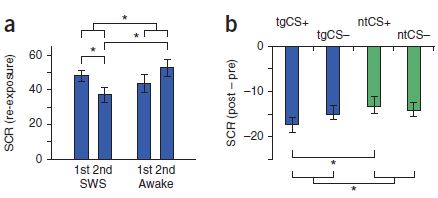Learning in your sleep?
Vocabulary:
slow wave sleep – a stage of sleep characterized by lack of rapid eye movement (REM) or dreams, and thought to be linked to restoration and recovery in the brain
amygdala – area of the brain that is involved in both memory and emotions. It receives many sensory inputs, but also gets input from higher order brain centers that form associations between ideas.
functional MRI (fMRI) – Magnetic resonance imaging (MRI) is a body imaging technique based on how different parts of the body react to radio waves within a strong magnetic field. Unlike x-rays or CT scans, it works well on soft tissues. functional MRI is an enhancement of the MRI, in that it is focused on the brain, and scans much faster but with lower resolution. It looks for changes in metabolic activity, as assumed from the ratio of oxygenated to unoxygenated hemoglobin in the red blood cells in that area of the brain. The assumption is that metabolic activity reflects neural/brain activity.
The article:
Hauner, K.K. et al. (2013) Stimulus-specific enhancement of fear extinction during slow-wave sleep. Nature Neuroscience. doi:10.1038/nn.3527
This article puts forth the possibility that we can train our brains to deal with our fears while we sleep. While it has long been known that sleep is an important process for consolidation of memories, and especially emotional memories, it was not known whether manipulation of the senses during sleep would register on the sleeping mind, and particularly on the most recent memories.
Fear factor
The experiment proposes that memories of a fearful situation can be countered by sense stimulation during sleep. The first matter of business then, was to create a fearful memory without risk of psychological or physical damage to the 15 test subjects. The researchers settled on a clear set of stimuli (a picture of someone’s face and a whiff of a citrusy odorant). Next, the subjects were conditioned with a series of pictures that showed either of two faces, and also puffed a specific odorant to associate with each face. Not so scary yet, but with one face/scent combination, there was also a 50% chance that the subject also received a mild electric shock (the shock was calibrated to each subject’s assessment as “uncomfortable but tolerable”). With the other face/scent combination, no shock was ever administered. A skin-conductance response test was used to show a fear response: the response would rise significantly when the “possible shock” face was shown to fear-trained subjects in comparison to untrained subjects.
Sleep effect
What does sleep do to this learned fear response? After the fear conditioning, test subjects took a nap of a little over an hour (~73 min average). When the subjects reached slow-wave sleep, some test subjects were presented with light puffs of odorant into their nostrils. The smell did not awaken the subjects, and they were unable to remember what scent they smelled after awaking.

(a) treatment with odorant during slow-wave sleep (SWS) lowers fear response, but treatment while awake does not. (b) using the fear-associated odorant (tgCS) has an effect, but using the odorant associated with the other picture (ntCS) does not.
Testing the subjects again, they found that those who had been given the smell associated with the fear-inducing face (and possible electric shock) had a significantly lower fear response. Those who were presented with the other scent showed no change, and then to see if it was really about the sleep, they did a similar test in which the test subjects were awake and viewing a film instead of sleeping, but being exposed to an odorant molecule at about the same time as if they had been sleeping. Even though the same amount of time had passed, and the odorant was again used without any electric shock, the fear response was actually higher than before.
Interpreting the result
As you might expect, it’s difficult to know what is happening inside the sleeping brain. The title of the article just states the observation: when the stimulus (specific odor) is given during slow-wave sleep without the electric shock, it actually leads to extinction, or at least a lessening of the fear. However, as the authors note, they cannot distinguish between the possibility that this results from “unlearning” of the connection between the odor and the possible shock, or if it is the result of “new learning” of a connection between the odor and a lack of painful consequence. My completely inexpert guess would have been the former, but in fact, they feel that they have some evidence that suggests the latter. Specifically, functional MRI scans seem to show the formation of a new area of activity in the amygdala, rather than a lowered activity in the original fear-odorant connection.

![By Exolune [2011, CC-BY-SA-3.0] via Wikimedia Commons](http://www.axopub.com/wp01/wp-content/uploads/2013/09/Projet_endormi.jpg)
No comments
Be the first one to leave a comment.